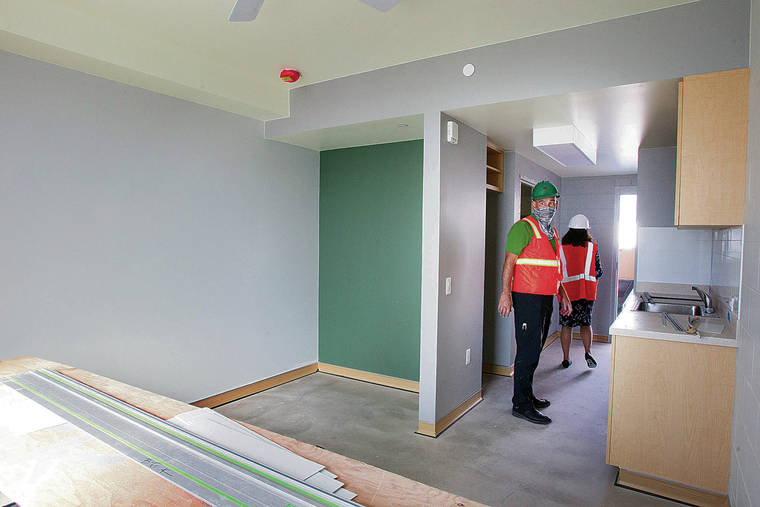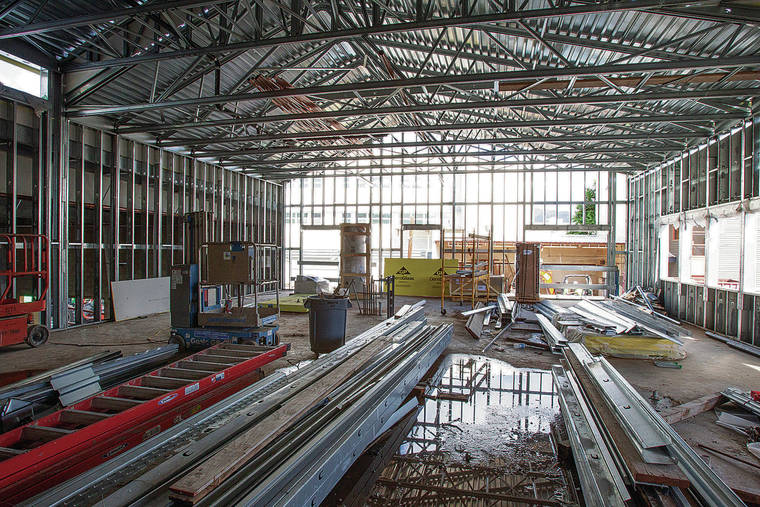River of Life Mission to shutter Chinatown food program, relocate

CINDY ELLEN RUSSELL / CRUSSELL@STARADVERTISER.COM
The commercial kitchen area, which also will provide job training.

CINDY ELLEN RUSSELL / CRUSSELL@STARADVERTISER.COM
A new four-story, 27-unit affordable housing complex and resource center in Iwilei is under construction and scheduled to be finished in May 2021. Above is the inside foundation of the resource center, which is a dormitory for the staff learning job skills at the complex.

CINDY ELLEN RUSSELL / CRUSSELL@STARADVERTISER.COM
A new 27-unit affordable housing complex and resource center in Iwilei is scheduled to be completed in May. Mayor Kirk Caldwell announced Wednesday that the River of Life Mission will operate the resource center, which includes a large commercial kitchen and dining facility for homeless individuals that will replace the current Chinatown location.



River of Life Mission, often maligned by Chinatown residents and merchants as a magnet for homelessness in Honolulu’s oldest neighborhood, will relocate to Iwilei and provide up to 700 meals per day in the city’s latest effort to reduce homelessness.
The new four-story, homeless “Resource Center” that’s still under construction at Sumner Street and Iwilei Road is intended as part of a complex of homeless services that already includes the city’s four-story Punawai Rest Stop just behind it. Across the street is the Institute for Human Service’s men’s shelter on Sumner Street, all within a block of a planned rail stop.
Punawai Rest Stop, which was built out of the old Malihini Sportswear factory on Kuwili Street, is designed to provide permanent housing in the form of 21 studio apartments on its upper floors.
The Resource Center, located at 806 Iwilei Road right behind Punawai, was the site of the former Montgomery Motors location. With the $3.9 million purchase price and construction, the total cost to the city is planned at $17.2 million, Mayor Kirk Caldwell announced Wednesday in one of his final acts as mayor.
It’s scheduled to provide hygiene needs and supplies and include meeting and counseling rooms and a multi-unit apartment for live-in staff to learn culinary skills and work in the commercial kitchen.
River of Life Mission would operate the Resource Center when it opens in late May, Caldwell said.
Don't miss out on what's happening!
Stay in touch with breaking news, as it happens, conveniently in your email inbox. It's FREE!
Twenty-seven studio apartments are planned on the top floors of the Resource Center for homeless people, those at risk of becoming homeless and low- income residents who could conceivably benefit from using rail, Caldwell said. Each apartment is planned to include “an efficiency kitchen with stove and refrigerator and a bathroom suite,” according to the city.
Unlike Punawai, the Resource Center is planned to include meal seating for more than 100 people and a commercial kitchen capable of preparing a total of 700 breakfasts, lunches and dinners per day, Caldwell said.
River of Life Mission would shut down its Chinatown operations and move over to the Resource Center when it opens, Caldwell said.
Unlike River of Life’s Chinatown food service, where homeless people line up on North Pauahi Street, people waiting for food at the Resource Center would not be in a public space. Instead, they would wait in a waiting room while getting a wide range of help, said Sandy Pfund, director of the city’s Department of Land Management.
Eric Wong manages 76 low-income apartment units above Chinatown’s Kekaulike Market and helped to organize a walking patrol of mostly senior Chinatown residents who report illegal homeless activity.
The week before Christmas, Wong found what appeared to be human feces outside the apartment building on Dec. 19, 21 and 22.
“After they eat their meal, River of Life doesn’t provide further assistance,” Wong said. “Obviously the bathroom is an issue after you feed somebody. It’s good for Chinatown to draw the homeless feeding away from the businesses and residents and makes our lives less stressful in dealing with the homeless. It’s not about River of Life. It’s about the unstable people they draw. It’s not everyone. It’s probably one out of hundreds of clients. But it’s that one that makes everyone wonder why River of Life should be in Chinatown.”
In a statement, Caldwell said: “River of Life Mission has served a vital service in our community for over three decades and counting. During the pandemic Opens in a new tab, as food insecurity rose across O‘ahu, River of Life switched to serving to-go meals to make sure our most vulnerable population was still taken care of and in a safer way. We’re glad that we are providing a platform for this non-profit organization to find a new space to continue its essential services in an area that’s central to the need.”



